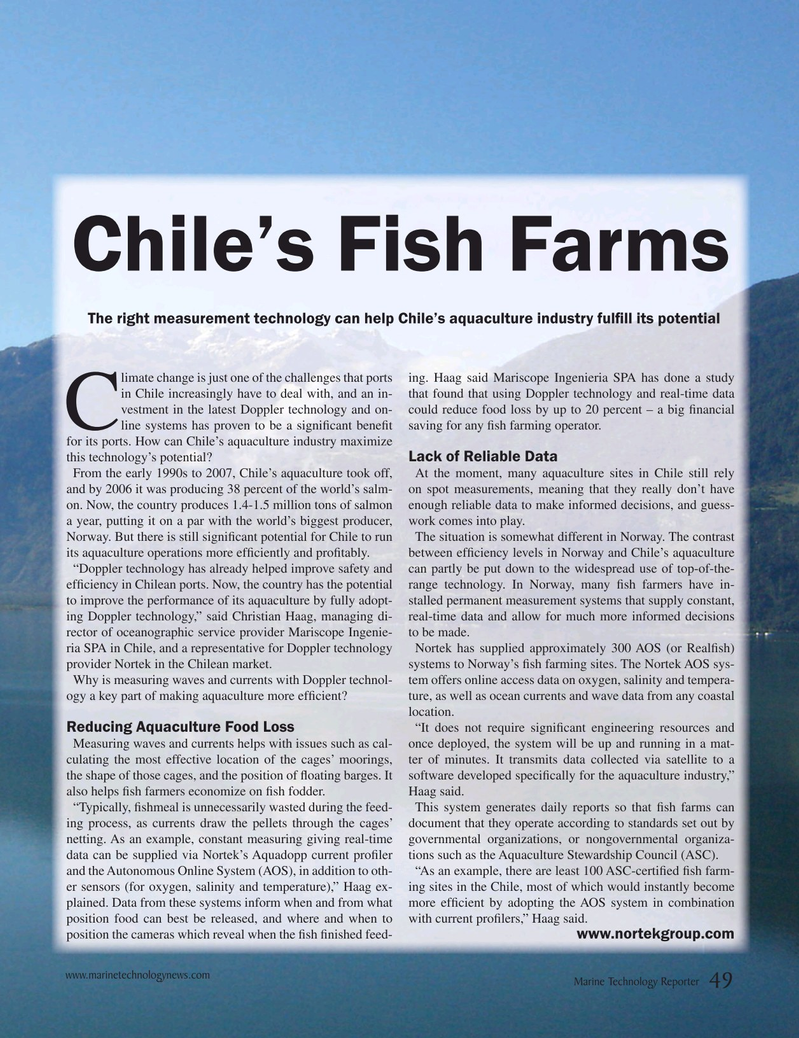
Page 49: of Marine Technology Magazine (September 2017)
Ocean Observation: Gliders, Buoys & Sub-Surface Networks
Read this page in Pdf, Flash or Html5 edition of September 2017 Marine Technology Magazine
Chile’s Fish Farms
The right measurement technology can help Chile’s aquaculture industry ful? ll its potential limate change is just one of the challenges that ports ing. Haag said Mariscope Ingenieria SPA has done a study in Chile increasingly have to deal with, and an in- that found that using Doppler technology and real-time data vestment in the latest Doppler technology and on- could reduce food loss by up to 20 percent – a big ? nancial
Cline systems has proven to be a signi? cant bene? t saving for any ? sh farming operator.
for its ports. How can Chile’s aquaculture industry maximize this technology’s potential? Lack of Reliable Data
From the early 1990s to 2007, Chile’s aquaculture took off, At the moment, many aquaculture sites in Chile still rely and by 2006 it was producing 38 percent of the world’s salm- on spot measurements, meaning that they really don’t have on. Now, the country produces 1.4-1.5 million tons of salmon enough reliable data to make informed decisions, and guess- a year, putting it on a par with the world’s biggest producer, work comes into play.
Norway. But there is still signi? cant potential for Chile to run The situation is somewhat different in Norway. The contrast its aquaculture operations more ef? ciently and pro? tably. between ef? ciency levels in Norway and Chile’s aquaculture “Doppler technology has already helped improve safety and can partly be put down to the widespread use of top-of-the- ef? ciency in Chilean ports. Now, the country has the potential range technology. In Norway, many ? sh farmers have in- to improve the performance of its aquaculture by fully adopt- stalled permanent measurement systems that supply constant, ing Doppler technology,” said Christian Haag, managing di- real-time data and allow for much more informed decisions rector of oceanographic service provider Mariscope Ingenie- to be made.
ria SPA in Chile, and a representative for Doppler technology Nortek has supplied approximately 300 AOS (or Real? sh) provider Nortek in the Chilean market. systems to Norway’s ? sh farming sites. The Nortek AOS sys-
Why is measuring waves and currents with Doppler technol- tem offers online access data on oxygen, salinity and tempera- ogy a key part of making aquaculture more ef? cient? ture, as well as ocean currents and wave data from any coastal location.
Reducing Aquaculture Food Loss “It does not require signi? cant engineering resources and
Measuring waves and currents helps with issues such as cal- once deployed, the system will be up and running in a mat- culating the most effective location of the cages’ moorings, ter of minutes. It transmits data collected via satellite to a the shape of those cages, and the position of ? oating barges. It software developed speci? cally for the aquaculture industry,” also helps ? sh farmers economize on ? sh fodder. Haag said. “Typically, ? shmeal is unnecessarily wasted during the feed- This system generates daily reports so that ? sh farms can ing process, as currents draw the pellets through the cages’ document that they operate according to standards set out by netting. As an example, constant measuring giving real-time governmental organizations, or nongovernmental organiza- data can be supplied via Nortek’s Aquadopp current pro? ler tions such as the Aquaculture Stewardship Council (ASC). and the Autonomous Online System (AOS), in addition to oth- “As an example, there are least 100 ASC-certi? ed ? sh farm- er sensors (for oxygen, salinity and temperature),” Haag ex- ing sites in the Chile, most of which would instantly become plained. Data from these systems inform when and from what more ef? cient by adopting the AOS system in combination position food can best be released, and where and when to with current pro? lers,” Haag said.
position the cameras which reveal when the ? sh ? nished feed- www.nortekgroup.com www.marinetechnologynews.com
Marine Technology Reporter 49
MTR #7 (34-49).indd 49 MTR #7 (34-49).indd 49 8/23/2017 4:24:44 PM8/23/2017 4:24:44 PM

 48
48

 50
50
